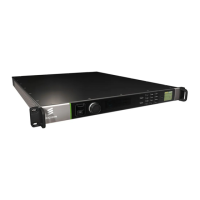• All Traps
Table 6.7 SNMP Interface Parameters
Parameter Description
SNMP Read Community The SNMP community name for read access. default = public
SNMP Location Textual description of the location of the unit
SNMP Contact Name of the person responsible for this unit
SNMP Trap Community The SNMP community name for read access. default = private
SNMP Trap Destination
The destination IP address for SNMP trap messages. Up to five destinations
can be defined, but by default none are assigned
SNMP Trap Alarm Level
Defines what events trigger the generation of an SNMP trap message. The
options are: Start Messages Only, i.e. only system start up events. Fail and
Start Messages only i.e. start-up events and critical alarms. All traps i.e.
start-up events and all alarms and warnings.
6.12 XPO
The unit supports an HTTP interface that is XPO2 compliant for configuration and
status monitoring. At least three simultaneous HTTP sessions can be supported.
HTTP access can be enabled or disabled.
Individual parameters can be controlled via XPO2. It does not require the complete
XML configuration to be sent to change a single parameter.
Note: The legacy XPO standard is not supported.
The web pages provide a service orientated control menu structure.
6.13 User Access
6.13.1 User Authentication
The unit supports user authentication as defined in the XPO Specification. By
default, user authentication is turned off. When set to On, a user name and
password is required to access the web pages. The default user name (engineer)
and password (password) can be changed by the user under the Encoder > Base
Unit > User Authentication node in Device Configuration > Advanced Setup
through the web user interface or in the Advanced/System/Base Unit/User
Authentication menu through the Front Panel.

